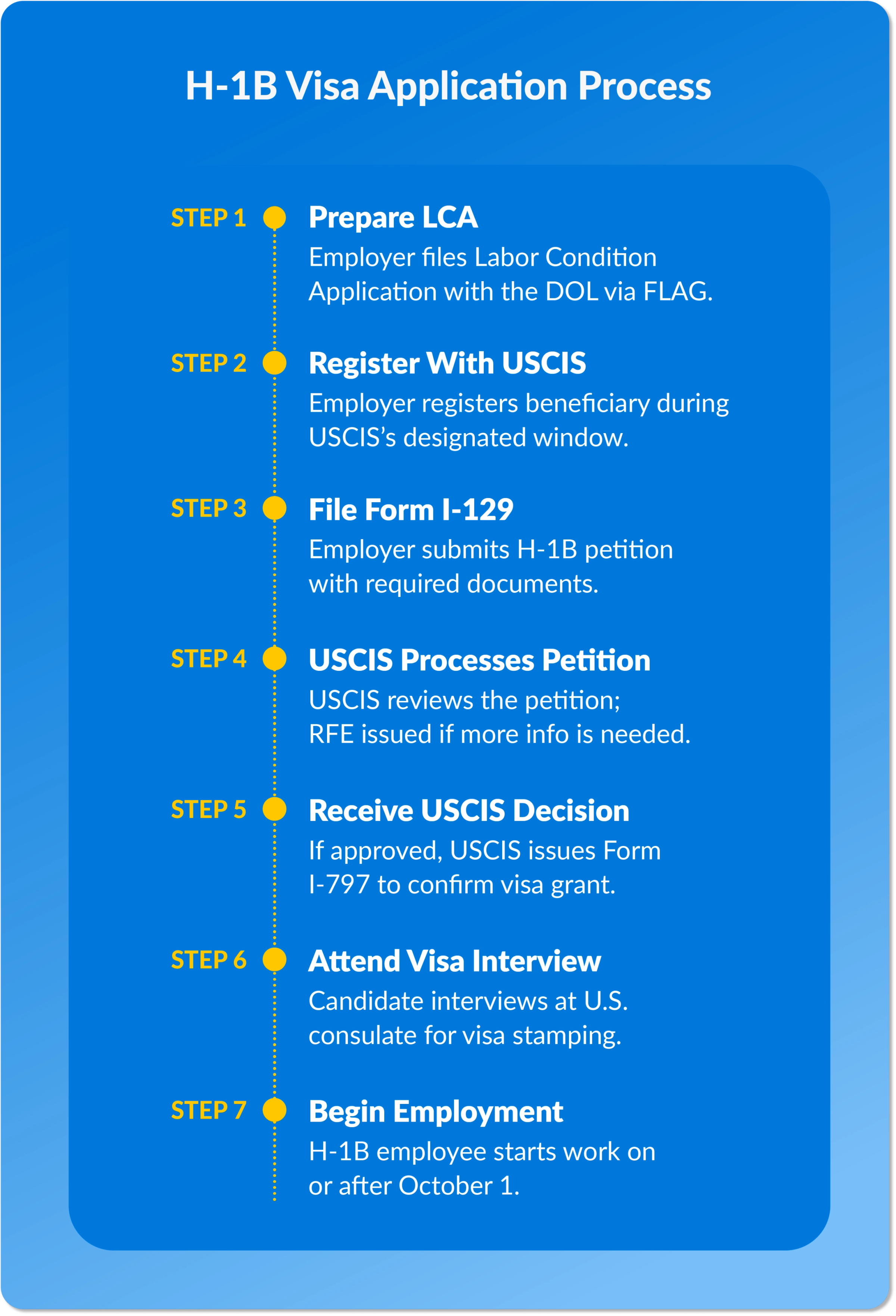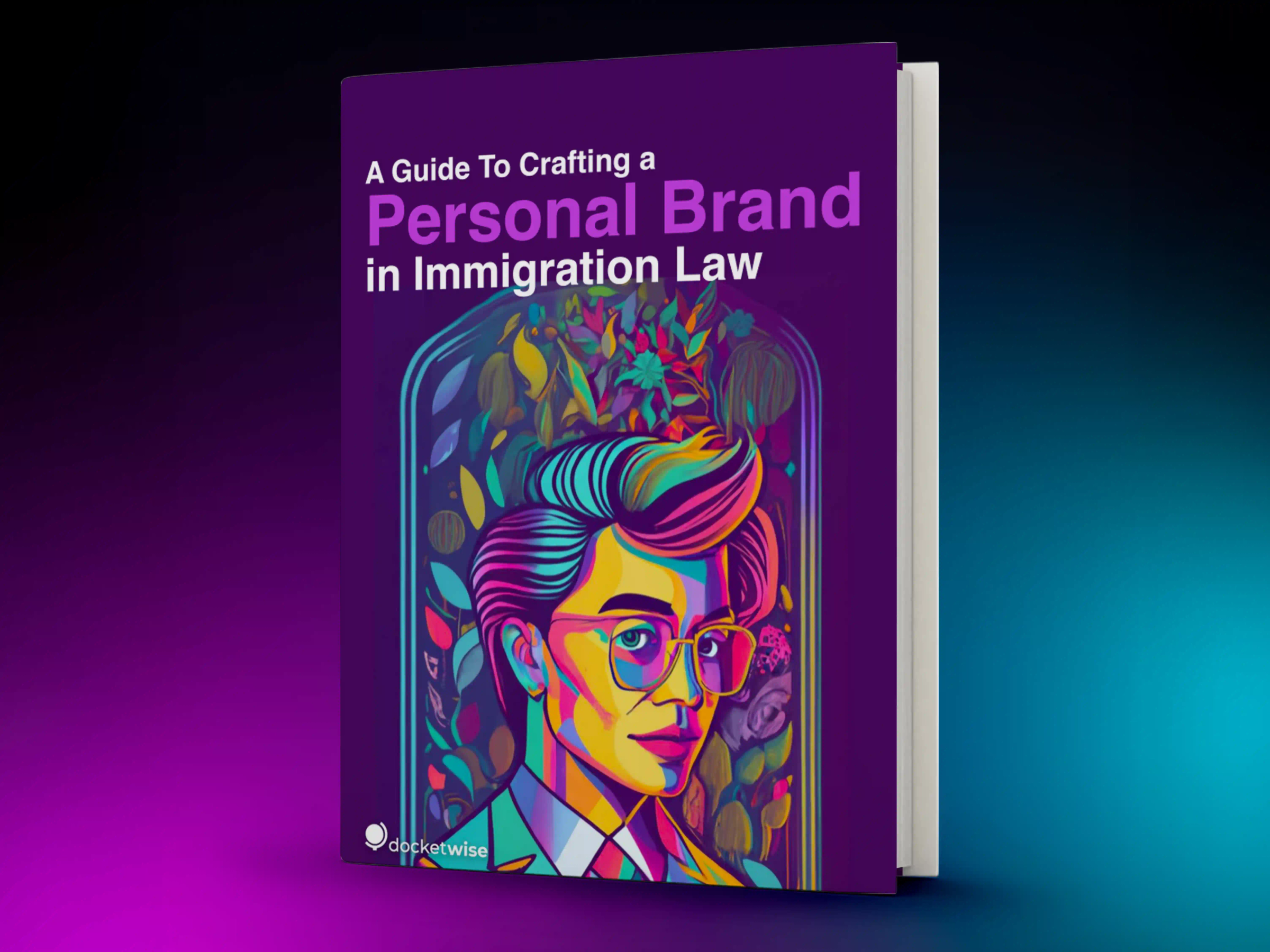Key takeaways
The H-1B process is initiated by employers who must register the intended employees they seek to sponsor and, for those approved to move forward, file I-129 forms.
The early phases of the H-1B petition process move quickly, which makes deadline tracking critical for immigration lawyers handling dozens of cases simultaneously.
Regulators are proposing changes to the H-1B process, which could affect how immigration lawyers handle these cases.
If your immigration law practice serves corporate clients, you will oversee the H-1B process. The H-1B visa is a nonimmigrant visa that permits U.S. employers to hire foreign professionals in specialized fields like engineering, IT, and healthcare.
The H-1B visa process is complex. Your corporate clients will need guidance managing the multiple steps from registration to filing labor condition applications, while ensuring compliance with the U.S. Department of Labor regulations. The prospective employees should have the process explained to them because they also face uncertainty as they move through the steps from registration to potential lottery selection.
While the Trump administration has suggested eliminating the lottery in favor of a more targeted selection process, those changes have not yet been implemented. In this article, we will review the entire H-1B visa process, including lottery selection. Use this guide to counsel corporate clients and their applicants on what lies ahead as they work to fill critical open positions in their organizations.
What Is the H-1B Visa and Who Is It For?
U.S. employers use H-1B visas to hire foreign workers for specialty occupations that require advanced skills. This visa is heavily used in technology, engineering, and healthcare, where highly skilled professionals are often in short supply in the U.S. job market.
H-1B candidates must meet these criteria to qualify:
Specialized job: The position must be in an occupation that requires expertise, training, and education. Examples include roles in software development, mechanical engineering, or medical research.
Educated: Applicants must have a bachelor’s degree or equivalent work experience. Degrees awarded from foreign institutions must meet U.S. standards.
Employer sponsorship: U.S. employers must file the visa petition. Applicants cannot apply independently.
The H-1B visa process begins with employers registering the potential employees they wish to sponsor with USCIS.
State of the H1-B Visa in 2025
In 2025, the Trump administration has focused on combating illegal immigration, but recent comments from USCIS Director Joseph Edlow imply potential changes to the H-1B work visa process as well. Edlow told reporters that the H-1B visa should prioritize higher-wage jobs, which could signal a modification to the current lottery selection system.
Edlow's comments followed reports that the Department of Homeland Security was considering a weighted selection H-1B process. In January, non-partisan think tank Institute for Progress suggested the H-1B program would have more economic value if registration selections were based on seniority or compensation.
A more targeted selection process, if implemented, may result in fewer H-1B registrations, as less qualified applicants would have a low chance of moving forward. H-1B registrations are already down 54% over the last two years. There were 780,884 registrations in fiscal year 2024 and 358,737 in fiscal year 2025. One factor in the decline was the implementation of a beneficiary-centric H-1B lottery, which counts each beneficiary once regardless of how many times that beneficiary was registered.
Updating the lottery process may not change the H-1B timeline, but it could pressure lawyers to be more strategic about the cases they accept and how they represent their clients.
H-1B Visa Requirements
Before learning how to apply for an H-1B visa, it's helpful to know the program rules. The H-1B visa requirements focus on the employer's role and the job itself, as well as the applicant's employment qualifications.
Employer Sponsorship
U.S. employers must sponsor H-1B visa applications. As the sponsor, the employer must comply with these regulations:
The job offered under an H-1B sponsorship must qualify as a specialty occupation. A specialty occupation requires a bachelor's degree or higher in a related field and the "theoretical and practical" application of specialized knowledge.
The compensation must be at least the prevailing wage for the position based on location and role.
The employer must file a Labor Condition Application (LCA) with the Department of Labor.
The employer must submit Form I-129 along with supporting documentation to USCIS.
Education and Work Experience
The H-1B visa applicant must also meet education, experience, and—sometimes—licensing requirements:
Education: The applicant must have a bachelor's degree or higher in a subject directly related to the job. If the degree is from an international institution, it must be equivalent to a U.S. bachelor's degree.
Experience: The applicant must meet the employer's requirements for specialized knowledge or experience.
Licensing: The applicant must have any state-mandated licensing or certification for that job role.
H-1B Visa Application Process: How to Apply
The H-1B process can be broken down into seven steps, beginning with registration and ending with a consular interview and employment. The so-called H-1B transfer process follows similar steps. This applies to situations in which a new and different employer files a petition on behalf of an existing H-1B visa holder, allowing them to change jobs and begin working for the new company.
Business immigration lawyers are typically involved in the entire process, representing their employer clients and often the applicants as well. Lawyers representing employers that frequently hire foreign nationals may manage all H-1B cases for that client or focus only on the more complex ones. This usually depends on how familiar the employer is with the H-1B process and what in-house resources are available.
Step 1: Employer Registers Each Beneficiary With USCIS
As a first step, employers must electronically register each H-1B candidate via the USCIS portal. Registrations are only accepted during a defined timeframe, which is announced by USCIS early in the year. The annual registration period can be as short as 14 calendar days, and each registration costs $215.
There are typically more registrations than the number of available visas, so USCIS uses a lottery to determine which registered candidates can move forward. Many applicants and employers ask how does the H-1B lottery work? The H-1B lottery is currently a random selection process. USCIS weights each beneficiary equally and chooses the allowed number of applicants randomly.
Employers are notified electronically if any of their registrations are selected. For those selected, employers can submit a visa petition (Form I-129) along with supporting documents specifically needed for the H-1B classification.
Step 2: Employer Prepares Labor Condition Application
LCA preparation is a critical step for employers looking to sponsor an H-1B visa applicant. The document must be filed with the U.S. Department of Labor and certified before the employer can petition USCIS for an H-1B visa.
The LCA includes information about the employer, the job and its compensation, the employer's attorney or agent, and working conditions. It also requires the employer to commit to complying with H-1B visa program rules. Specifically, employers must:
Show that hiring foreign workers won’t negatively impact wages and working conditions for current U.S. employees.
Pay the foreign worker the prevailing wage rate for that job. This is generally the average wage paid to similarly employed workers in the same occupation and geographic area.
Employers can determine the prevailing wage by requesting it from the National Prevailing Wage Center (NPWC) or by accessing the data through another recognized source. A common method is to look it up directly using the wage search tool on the Office of Foreign Labor Certification (OFLC) website.
Wage calculations on the LCA must comply with DOL guidelines. Additionally, LCAs must be filled out completely and accurately. These documents are submitted to the DOL through the Foreign Labor Certification Gateway (FLAG). Processing times typically range from seven to 14 days.
Step 3: Employer Submits the H-1B Petition (Form I-129)
Form I-129, filed by the employer, petitions USCIS to grant the candidate's H-1B status. The H-1B petition process requires more than the form itself—the submission must also include these supporting H-1B documents:
Proof that the job qualifies as a specialty occupation
Evidence of the beneficiary’s qualifications for the role, including proof that they meet all state licensing requirements
A copy of the certified LCA
A copy of any contract that exists between the employer and the applicant, or the proposed compensation package, and terms of employment
You can use this H-1B documents checklist to stay organized.
Step 4: USCIS Receives and Processes the Petition
After the employer files the Form I-129, USCIS processes the petition. Under normal processing, this takes five to seven months. Employers may choose to pay for expedited processing, which can shorten the timeline for USCIS to take action to 15 business days.
If USCIS requires more information to approve the petition, the employer will receive a Request for Evidence (RFE). An RFE is a formal request from USCIS for additional evidence, and it must be answered within the specific timeframe stated in the notice, typically up to 87 days from the date the RFE was issued.
Step 5: USCIS Decision and Approval
USCIS will approve or deny all I-129 petitions. If the petition is approved, the employee receives Form I-797, a Notice of Action, signaling the H-1B visa has been granted.
Step 6: Visa Stamping in the U.S. Embassy/Consulate
Workers outside the U.S. must attend an interview at a U.S. consulate or embassy to have an H-1B visa sticker placed in their passport.. They must bring supporting documentation to the interview, including:
Form DS-160, U.S. visa application, confirmation page, and proof of payment
I-797 approval notice
Passport valid for at least six months
Appointment confirmation letter
Certified LCA
Proof of employment and qualifications, such as the job offer letter and any educational certificates
Following a successful interview, the H-1B visa is affixed to the worker’s passport, which allows lawful entry into the U.S.
Step 7: H-1B Visa Status and Employment
H-1B visa holders can begin working for the sponsoring employer on or after October 1. The applicant is approved initially for a stay of three years, and extensions may be granted through filing a Form I-129 for an extension of status, up to a maximum of six years. If the employee wants to move into a different job, the new company must file a change of employer petition (also known as an H-1B transfer).

H-1B Visa Process Timeline: How Long Does It Take?
The H-1B visa process timeline can be lengthy, and each step has unique timing constraints and parameters. Below is an outline of these stages and how long each could take.
LCA processing: The process time is up to 10 business days. LCAs are filed with the Department of Labor. As long as the LCA is complete, accurate, and compliant, it should be certified within seven to 10 business days.
Applicant registration: This may be up to 14 business days. USCIS accepts candidate registrations in March, usually for two weeks.
Lottery announcement: It takes about seven business days. After the close of registration, USCIS only takes a week or so to complete the lottery. In 2025, the registration period closed on March 24, and lottery selection was complete by March 31.
Petition window: The petition window is 90 days. Employers have at least 90 days to submit I-129 petitions for selected candidates.
USCIS processing: Processing takes four to eight months. Under regular processing, a decision on an I-129 petition can take four months or longer, especially if USCIS issues a Request for Evidence (RFE). Premium processing shortens USCIS’s response time to 15 business days, though this may include an RFE rather than a final decision.
Visa stamping: This can take a few weeks to 5 months. The timeline for visa stamping varies by embassy or consulate location. The U.S. Department of State provides estimated wait times by location.
Combining all of these stages, the total H-1B processing timeline is typically one to two years if premium processing is not used.
What Comes After an H-1B is Approved?
As an immigration attorney, you should be prepared to brief your clients on what happens after an H-1B petition is approved. For candidates not currently in the U.S., the next steps are:
Getting a visa issued at a U.S. embassy or consulate
Traveling to the U.S. and presenting the visa and an I-797 approval notice
Applicants already in the U.S. and those entering the country can begin working for the employer on October 1.
It’s important to note that H-1B approval authorizes the applicant to work only for the employer that filed the petition, and only under the terms specified in the petition. Any changes to the employment terms that conflict with the details provided on the petition—such as a promotion, relocation, or shift in job duties—could affect the employee's immigration status and may require an amended petition.
Without any employment changes, sponsoring employers and their employees should track extension deadlines and remain compliant with all H-1B rules.
Challenges Business Immigration Lawyers Face with the H-1B Process
The H-1B process includes long waiting periods plus short bursts of intense activity—a dynamic that creates unique challenges for business immigration lawyers. Without efficient workflows, attorneys may find themselves overwhelmed by high client expectations, overlapping registrations, and changing regulatory requirements. This pressure can lead to burnout and increase the risk of errors, which can ultimately impact the client experience.
1. High Client Expectations and Communication Burden
Business immigration lawyers typically represent the employer, though in some cases, they provide dual representation, meaning they represent both the employer and the candidate. Attorneys must navigate this arrangement carefully by ensuring clear communication, informed consent, and awareness of potential conflicts.
Keep in mind that employers may have high expectations for resolution timelines, while candidates may feel the stress of a major life transition ahead. Both sides are under pressure, and as a result, lawyers often receive repetitive questions, frequent requests for status updates, and anxious check-ins.
While understandable, this volume of communication can be difficult to manage without disrupting other work. Responding effectively requires time, patience, and a well-organized process.
2. Managing High-Volume H-1B Registrations During Lottery Season
Because the H-1B registration window is short, business immigration law firms may manage dozens or hundreds of registrations simultaneously. Manual processes for tracking these registrations and preparing forms can be time-consuming and increase the risk of mistakes.
A similar rush of simultaneous cases can also happen once the lottery is complete. Employers have just 90 days to file petitions for selected candidates, which is especially challenging for those who have to file on behalf of multiple applicants.
To work effectively in these busy seasonal periods, immigration lawyers must establish reliable processes to avoid missing deadlines or losing track of cases.
3. Staying Compliant Amid Constant Regulatory Updates
Immigration lawyers are under constant pressure to stay current on evolving rules, while ensuring their filings meet the latest USCIS requirements.
As an example, USCIS moved to a beneficiary-centric lottery process in 2024. The new selection process counts each beneficiary once, regardless of how many registrations were submitted for that beneficiary. Regulators are also considering allowing eligible H-1B visa holders to renew their visas in the U.S. A 2024 program piloted this change successfully.
4. Risk of Burnout from Repetitive, Non-Billable Tasks
Small law firms can have limited administrative resources. Solo practitioners may be responsible for all administrative functions on top of client work. In both situations, lawyers can find themselves divided between case strategy, relationship management, client follow-ups, and deadline tracking. Burnout can result from repetitive, non-billable tasks and competing priorities.
How Lawyers Can Expedite the H-1B Process
Managing the H-1B visa process efficiently is key for immigration lawyers to avoid complications and overcome the common challenges these cases can present. Four essential strategies include using a client portal, leveraging e-filing, relying on case management software, and automating deadline tracking.
Utilize a Client Portal
A client portal is a convenient tool that enables clients to upload their documents, complete questionnaires, check case statuses, and communicate with their lawyers in a secure environment. The technology minimizes miscommunication, keeps all relevant information secure, and reduces time-consuming back-and-forth by consolidating the communication in one place.
Immigration lawyers can use a client portal to keep themselves and their clients organized. Directing clients to the portal for case updates can be particularly effective with anxious clients who need regular reassurance. Lawyers can focus on keeping the portal updated to minimize excessive client check-ins.
Leverage E-filing to Speed Up the Process
E-filing has simplified the H-1B application process. Platforms such as Docketwise allow lawyers to submit petitions digitally, reducing the likelihood of errors and accelerating the process. E-filing provides instant confirmation of receipt by the agency and, in USCIS cases, immediate access to the receipt number—eliminating the typical two-week wait for a mailed notice.
Use Case Management Software
Keeping client data and deadlines organized is critical in the H-1B visa and H-1B transfer processes. Case management software provides a framework for that organization through the use of workflows and deadline tracking. Centralizing client information lessens the time lawyers spend searching for data. The technology also tracks case statuses and generates forms automatically.
These automations can improve efficiency and accuracy, particularly for lawyers who are handling multiple H-1B cases simultaneously.
Automate Tracking of Deadlines and Timelines
The early phases of the H-1B process happen quickly, making deadline tracking essential. Lawyers can use software to set automatic reminders for key dates, like the filing of the Labor Condition Application and Form I-129, to stay current with important submissions and prevent missed deadlines.
Docketwise Supports the H1-B Process
For immigration lawyers, H-1B workflows are complex, while short timelines and large caseloads leave no room for error. Under these pressures, immigration law technology is a valuable tool for organizing and streamlining case management, client communication, form generation, and deadline and task tracking.
Docketwise has several features that directly support immigration lawyers handling H-1B petitions:
Automatic immigration form completion: Auto-populate forms based on the client's intake answers.
Client portal: Keep clients updated on case status with minimal effort.
Task automation: Standardize workflows and client notifications with customizable templates.
Automated case tracking: Docketwise eliminates manual case status checks by pulling updates into the case file automatically.
To see Docketwise in action, schedule a demo today.
H-1B Process FAQs
Carve Your Niche in Immigration Law
Unlock the potential of your personal brand and set yourself apart in the world of immigration law. Harness the tools, strategies, and insights to become the go-to expert in the immigration law landscape.
Download Now
About the author

Catherine Brock
Catherine Brock is a Content Writer for leading legal software companies, including MyCase, Docketwise, and CASEpeer, as well as LawPay, the #1 legal payment processor. She covers emerging legal technology, financial wellness for law firms, the latest industry trends, and more.
